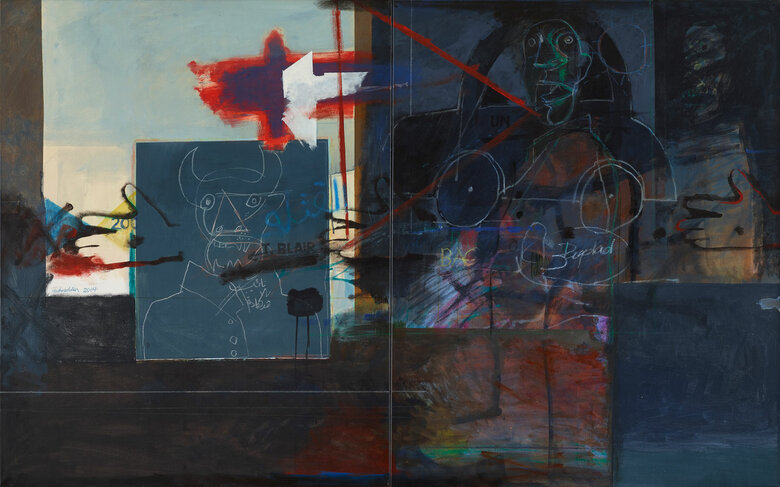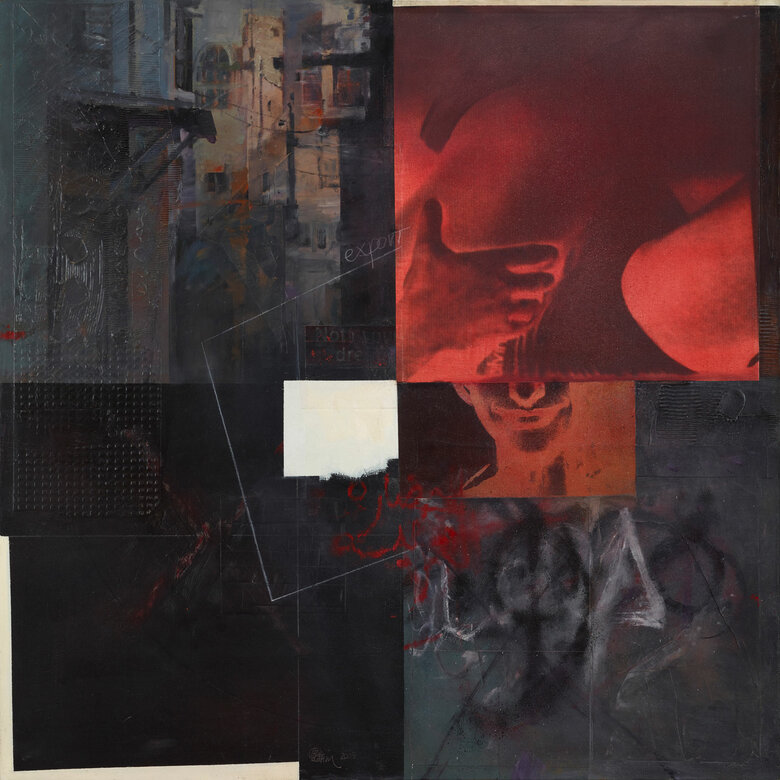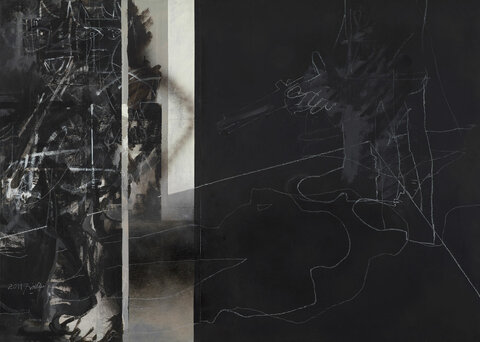Untitled, 1990 is an abstract painting composed of primary geometric forms: squares and rectangles organized structurally. Two equally broad horizontal rectangular planes fully extend onto the edges of the canvas and split it in the middle, serving as a backdrop to a big monochromatic blue-green square that dominates almost half of the painting’s central foreground. The upper section of the background features two horizontal planes of pigment that vary in size and color and can be described as flat and minimal. In it, the artist fills the large plane in radiating yellow paint topped with a thin petroleum blue band. Muhraddin punctuates the yellow background with a wide horizontal band painted with thick black acrylic paint in a swift brush stroke. He creates a striking contrast. As for the lower section of the background, the artist applies washes of dark burnt umber where traces of soft brushstrokes counter what might otherwise be a rigid geometric composition. The base of the lower section depicts a thin rectangular plane in petroleum blue with two arrows annotating a distance of 100 meters.
Set against complementing yellow hues, the central blue-green square demands the viewer’s attention and is crowded with contradicting denotations. The artist uses shades of petroleum blue, some subtly light others dark, to create a sense of harmony. The left part of the square features messy charcoal scribbles in a rhythmic elliptical motion topped by minor reversed writings of Arabic letterings using pencil marks. At the right part of the square, we see a vague impression of a figure within a rectangular frame painted in low values of blue applied with soft, seamless brushstrokes.
The vertices of two triangles intercept the shadowy figure from above and below. The triangle above is small and inverted; it is painted with gradations of blue, while the other is bigger and simply outlined. These complex and interlocking graphic components are reminiscent of graffiti visual elements, often found on revolutionary street city walls. Finally, the artist balances out the composition by placing the main square in the central foreground to communicate stability and solidity. Yet this sense of stability is quickly refuted by the curved and twisted lines inside the square, conveying turmoil, chaos, and confusion.
Untitled, 1990 attests to the Iraqi artist Muhammad Muhraddin’s experimentation with western modernist principles of abstraction to comment on his homeland's social and political realities. He does this through his mindful use of text and words that often carry a heavy ideological resonance. Being a founding member of the New Vision Group in Iraq (1968) along with Dia Al Azzawi, Rafa Nasiri, and others, Muhraddin profoundly engaged in contemporary socio-political issues. These artists shared commonalities in the emancipation of art from traditional stylistic constraints and regarded the artist as a revolutionary critic.
In this piece, we notice how, among the different mathematical formulas and symbols he uses, Muhraddin clearly inscribes the word “لا”(which reads 'La'), meaning “No” in Arabic, placed to the left of the painting within the main blue-green square. This word is the only one that escapes the boundaries and extends beyond the square with a thin green-painted strip. This can signify the artist’s rebellious attitude in refusing the turbulent realities of his country. In addition to that, incomprehensible writings highlight feelings of confusion and misunderstanding. All of this can be traced back to the human anxieties and crises experienced in the 1990s when this painting was created and a period of increasing isolation due to the long years of the Iraq-Iran war.
Taking a step back, we notice how the repetitive horizontal layering in the background helps Muhraddin achieve visual harmony and signify a sense of rest and repose as objects parallel to the earth are at rest. While the central blue-green square boasts crowded details and chaotic energy, the bareness of its background serves as a negative space that represents its opposite serenity. The color arrangement of the background almost mimics a barren landscape. When the blue-green square rests alone in the middle, it heightens feelings of isolation, repression, and estrangement that Iraqis could have felt during that period.
Muhraddin uses juxtaposition, proportion, and color compositions to create a harmony of contrasts that increase the poetic dimensions of the painting and produce a heavy emotional impact that screams for freedom of speech, defies censorship, and calls for liberation during repressive times. It is a powerfully orchestrated work, compact and rich, with an articulated group of elements carried across the entire field of the canvas to portray an expressive dance between darkness and light, a hopeful cry for life, for salvation.










